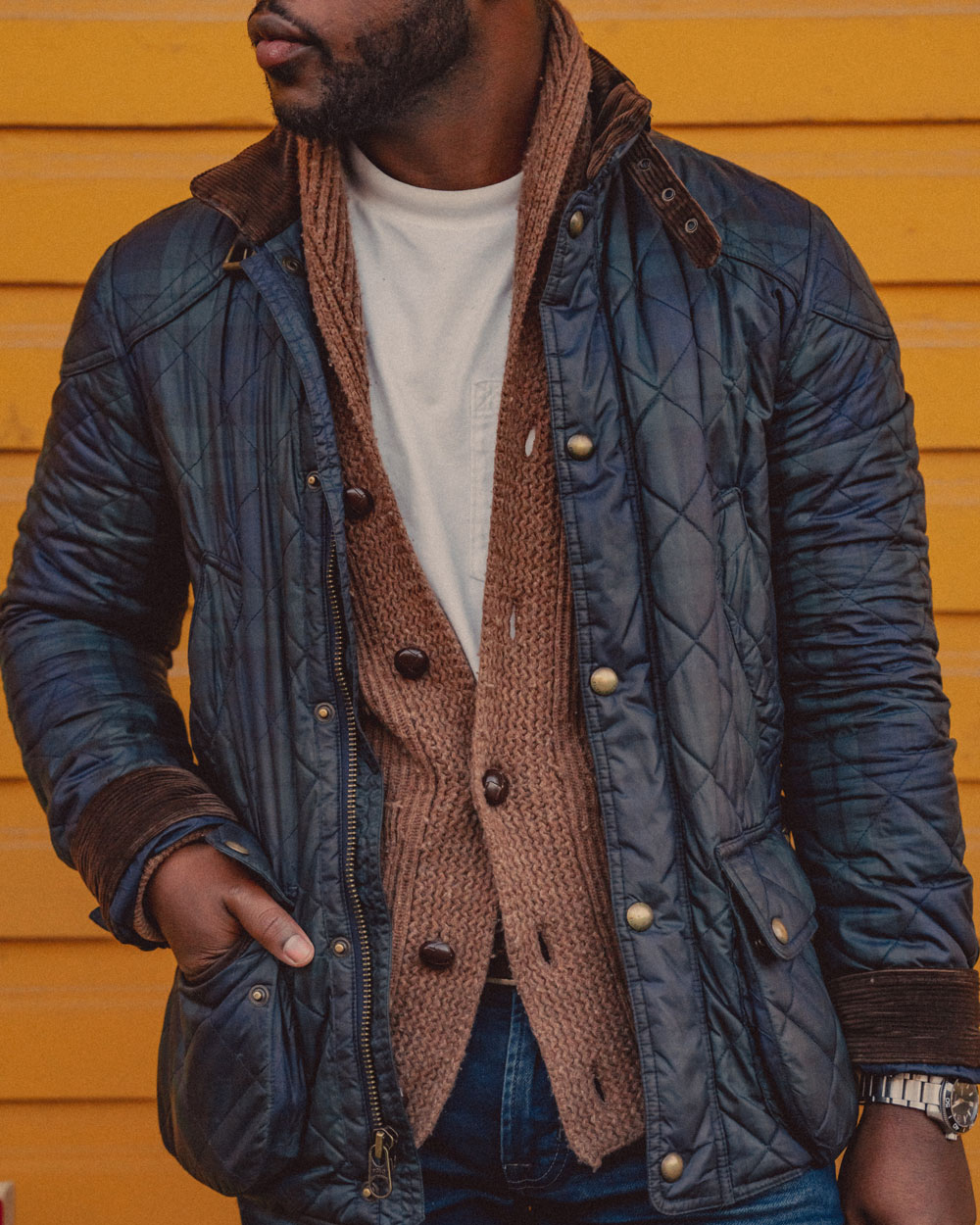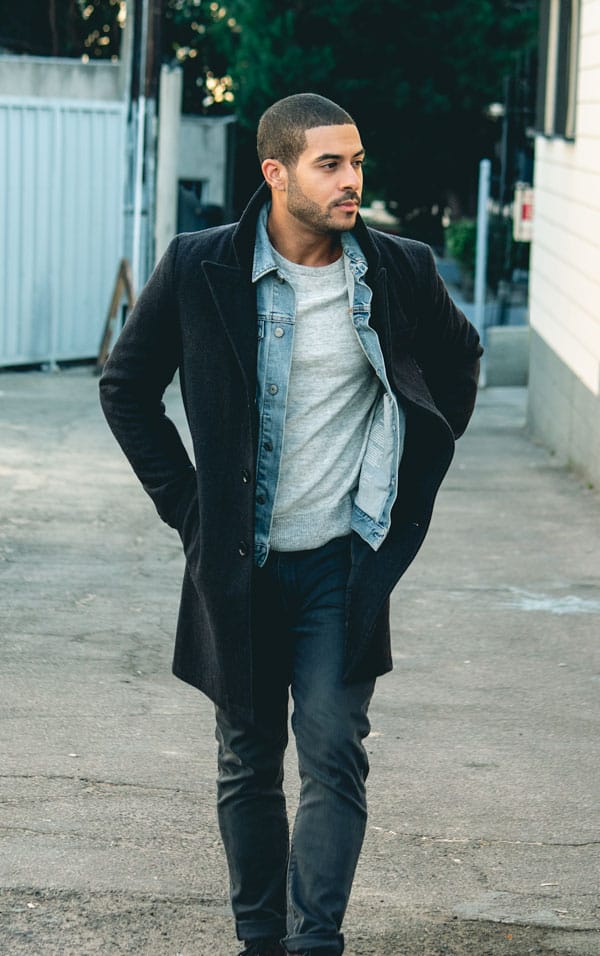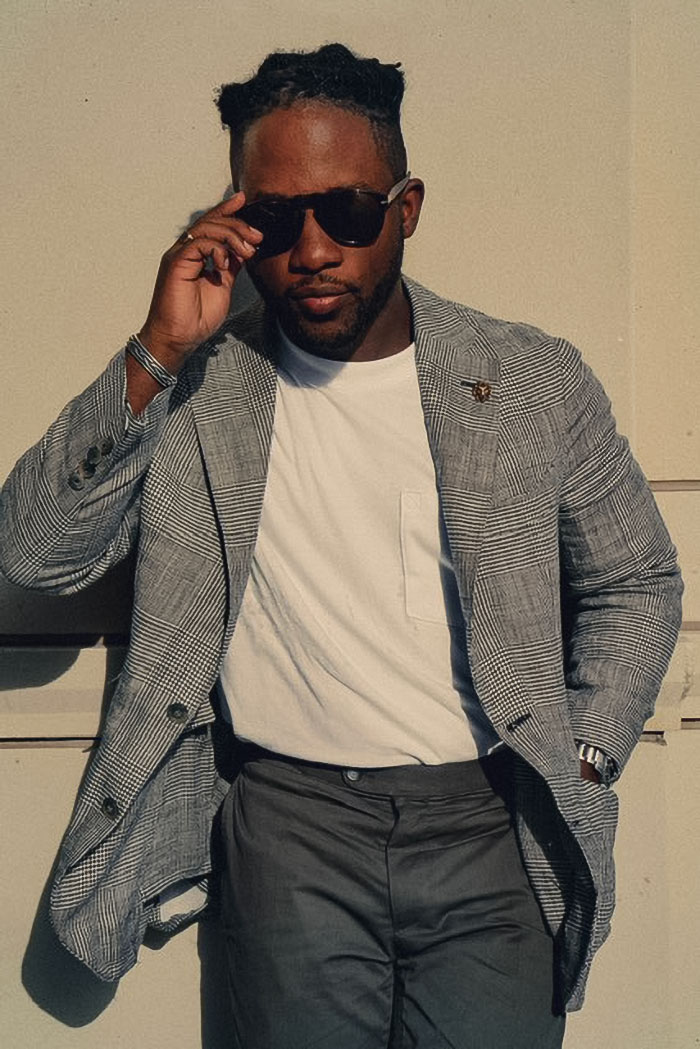Consider this when you’re stuck staring into your closet.
Ah, the crisp morning air of late spring. It’s the perfect time to throw on a favorite light layer or two, grab a hot cup of coffee, and hit the day running. But have you ever paused to think about why some layered outfits look effortlessly stylish, while others appear haphazardly thrown together?
It’s all about hierarchy. Yes, you read that right. When it comes to style, particularly in layering, the concept of hierarchy plays a pivotal role.
“Layering is one of the most important skills you can master for style when it comes to transitionary months,” says Daniel Z. Baraka, a style contributor for Primer, whose personal style makes use of a lot of layering. For the purpose of demonstrating this vital principle, Daniel has styled an outfit that is both simple and sophisticated, centered around classic wardrobe staples.
“For this particular outfit, I went very basic. White t-shirt, blue jeans, sneakers. These are staples that everybody has in their wardrobe,” Daniel says. But why does the outfit feel elevated if its components are so everyday?
“There needs to be a certain hierarchy in how you layer pieces. Whether that is from a color perspective, a texture perspective, or pattern perspective,” Daniel explains. The outfit exhibits this principle beautifully with a white t-shirt, a brown wool shawl collar cardigan, and a black watch tartan quilted jacket. The colors range from light to dark, thus providing a hierarchical structure in terms of shade.

But, it doesn’t stop at color. Have you ever thought about texture in your attire? Daniel gives us something to chew on here too: “The t-shirt has no texture at all. And then the cardigan has more texture thanks to its knit. Then the quilting added to the intricate black tartan makes the texture of the jacket the most complex of all the textures,” Daniel describes.

Hierarchy is a hidden gem in the world of personal style. Up until now, we’ve focused primarily on color and texture. But, just like the wide variety of fabrics hanging in your closet, the concept of hierarchy in style is more diverse than you might think. Beyond the simple light-to-dark spectrum, or the complexity of textures, lies another couple of fascinating concepts: fit hierarchy, formality hierarchy and emphasis hierarchy.
You can also employ a hierarchal structure to fit, creating a balance with different levels of tailored and looseness. For example, a tailored shirt, a fuller cut but cropped jacket, and looser pants:

Beyond color, texture, and fit, you can also create a formality hierarchy. Picture this: a simple cotton shirt paired with a classic denim jacket, topped off with a wool topcoat. You may think, “Wait a minute, isn’t that a bit too formal for a t-shirt and jean jacket?” But therein lies the beauty of a formality hierarchy.

A formality hierarchy is all about creating a balanced “smart casual” effect, where the innermost or outermost layer is the most casual, and as you move in the opposition direction, the attire becomes increasingly formal. Daniel points out, “This balance creates a style that’s neither too laid-back nor overly formal, but just the right mix to make a subtle statement.” With a formality hierarchy, you can elegantly traverse between casual outings and semi-formal engagements without needing an outfit change.

On the other hand, emphasis hierarchy takes a slightly different approach. It revolves around creating a focal point within your outfit. Imagine you’re wearing a predominantly monochrome or neutral outfit. However, you decide to throw on a bold, orange statement sweater. This now becomes the “star” of the outfit – the focal point.
Emphasis hierarchy is all about creating contrast, drawing attention to a specific item of clothing or accessory. It could be a piece with a bold color, an eye-catching pattern, or an interesting texture that stands out from the rest of the outfit. This standout piece then becomes the central point of your ensemble, while the other items serve as the supporting cast, complimenting and elevating the “star.”

But remember, it’s all about balance. A bold statement sweater finds structure and balance with the rest of your outfit when the other items are more muted. After all, you wouldn’t want your clothes competing for attention.
It’s important to clarify that hierarchies are just tools not rules, you can use while assembling outfits: It is absolutely possible to create a stylish look that doesn’t fit within a hierarchy.
Moreover, Daniel’s outfit teaches us that style does not necessarily equate to extravagance. “The jacket is ten years old from Polo Ralph Lauren, which I got on eBay, so its even a little bit older. And so the whole outfit is pretty cheap, but it looks really nice,” he shares. His mix of brands like Magnani, American Eagle, Abercrombie and Fitch, and J.Crew further emphasizes the point that a well-coordinated outfit can transcend the sum of its price tags.

Style is an outward expression of our individuality and personal aesthetic preferences. Understanding the principle of hierarchy in clothing doesn’t just boost our dressing prowess, it also provides a template to make better use of the existing pieces in our wardrobes. And of course, in Daniel’s words, “Once you master this, there are so many ways to break the rules and make it your own.”
What makes this discussion even more pertinent is the time of year – late spring, right on the brink of summer. It’s the time when layering can be both an aesthetic choice and a practical one. You want to look good, but you also need to account for the shifting temperatures and unpredictable weather. Here again, Daniel’s layered outfit serves as a fitting example. His black watch tartan quilted jacket is not only a stylish addition but also provides a much-needed shield on those cooler spring days or sudden downpours.
Fit, Formality, and emphasis hierarchies, much like color and texture hierarchy, add another layer (pun intended) to your outfit, giving it depth and dynamism. Whether you’re stepping out for a casual coffee run or attending a meeting, mastering these hierarchies can help you present yourself in the best light. So, why not give them a try the next time you get dressed? Go ahead, experiment with the concept of hierarchy, make it your own, and let your outfit tell a story.
